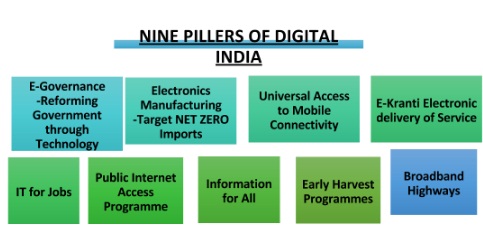E-SANSAD : Important Topics for UPSC Exams

E-SANSAD
What is E-sansad?
It is a program under Digital India (e-Kranti - Electronic Delivery of Services). e-Sansad has a state counterpart as e-Vidhan. This project plans to digitise all Parliament documents. Union Ministry of Parliamentary Affairs (MoPA) is the Nodal Ministry for implementation of both the projects. This is also in consonance with Go Green Initiative, which will further limit cutting of trees for making paper. The project will also help in fulfilling the commitments towards Paris Climate Agreement and Sustainable Development Goals as going paperless is directly related with Environment Protection.
Benefits of e-Sansad project
Takes Less space and further storage requirements are reduced. This project will help in moving towards effective delivery of Goods and services through e- Governance mechanism. E-sansad project will ensure transparency and accountability in the Governance Mechanism and a forward step towards a welfare oriented and citizen centric Democracy.
What is e-Governance?
e-Governance is, the application of Information and Communications Technology
to government functioning to create ‘Simple, Moral, Accountable, Responsive and
Transparent’ (SMART) governance. e-Governance facilitates interaction between
different stake holders in governance. The aim of e-Governance under the
National e-Governance Programme is reaching out to villages in the shortest
time, with minimum cost and maximum transparency.
Govt has started Digital Vans for promoting awareness towards E- Governance.
These digital vans are equipped with Internet and audio-visual facilities. It is
an initiative of the Department of Electronics and Information Technology, and
will be implemented by the National e-Governance Division. To increase awareness
among people, especially youth, about various e-governance services in rural and
semi-urban areas. To reach out to rural citizens for MyGov, digital locker,
Aadhaar and other digital services.
The experiences in e-governance, can be replicated in e-learning, e-health, e-commerce as well.
Challenges associated with the success of e-Sansad project
Some States have adopted automation still huge amount of Paper is being consumed in state departments. So behaviour change is the issue.
How digital/e- Literacy can limit the success of Projects like e-Sansad and e- Vidhan?
In simple words digital literacy is the skillset which facilitates the use of devices like smartphones, tablets, laptops and desktop PCs. People in India are lacking in terms of either devices or the skillset. And majority of rural India is lacking in Both aspect, as approximately 30% of Indian population living below poverty line. Since majority of Rural Population don’t know English while most of the content in the internet is in English this further limits their accessibility to various electronic services.
What are the various issues with Internet Penetration in India and how they affect e-delivery of services?
Latest TRAI (Telecom Regulatory of India) Report, which is one of the most authentic report, stated that Internet penetration in India is very low. In India 28.77 Internet subscribers per 100 population use internet. Thus, the question arises if such a huge population is not digitally literate then how Digital India can prove to be successful.
How Digital Divide is an impediment in Implementing e- Governance in India?
In India Internet connections are unevenly distributed. According to the TRAI report urban India has 61.9 Internet subscriptions per 100 people, while rural India gets by with just 13.7. Delhi alone has 2.2 crore Internet connections, whereas the entire North East has just 4.3 lakh. This shows the widespread regional disparity as well as Rural- urban Divide in terms of Internet connections.
Limited success of Digital India Campaign
Govt steps taken in the direction of Digital India are not effective enough. MyGov.in as a platform for citizen engagement in governance, has remained a limited success. Other initiatives like eSign framework which allow citizens to digitally sign a document online using Aadhaar authentication has not seen considerable growth.
What are the various other initiative for the effective e-Governance?
Digital India
Aim of Digital India is Spreading of information without barriers. 'Digital India' program envisages that by the year 2019, the 250,000 Indian villages will enjoy broadband connectivity, and, universal phone connectivity. This programme has been envisaged by Department of Electronics and Information Technology (DeitY). Digital India focuses on nine pillars of growth, e-governance: Reforming Government through Technology, namely Broadband Highways, Universal Access to Mobile connectivity, e-Kranti-Electronic Delivery of Services, Public Internet Access Programme, Information for All, Electronics Manufacturing, IT for Jobs and Early Harvest Programmes.

Buy Printed Study Material for UPSC Pre General Studies (Paper-1)
Online Crash Course for UPSC PRE Exam
Digital Village
It is in line with the vision of Digital India. Components of Digital Village are Providing Tele Medicine services, Tele Education, Skill Development.
Pradhan Mantri Gramin Digital Saksharta Abhiyan (PMGDISHA)
Aim of ‘Pradhan Mantri Gramin Digital Saksharta Abhiyan’ is to make 6 crore rural households digitally literate by March 2019. If implemented successfully it is expected to be one of the largest digital literacy programmes in the world. The implementation of the scheme would be carried out under the overall supervision of Ministry of Electronics and IT in active collaboration with State/UTs through their designated State Implementing Agencies, District e-Governance Society (DeGS), etc.
Way Forward
We must focus on digital literacy and leverage technical skills to reap the benefits out of an increasingly global, digital and innovation-driven economy and to ensure the success of projects like e-sansad.
MODEL QUESTIONS
Which of the following statement about e-Snasad and e- Vidhan are correct?
- Union Ministry of Parliamentary Affairs (MoPA) is the Nodal Ministry for implementation of both the projects.
- It is a program under Digital India.
- The project will also help in fulfilling the commitments towards Paris Climate Agreement.
Select the correct answer using the code given below.
A. 1&2 Only
B. 2&3 Only
C. 1&3 Only
D. All of the above.

